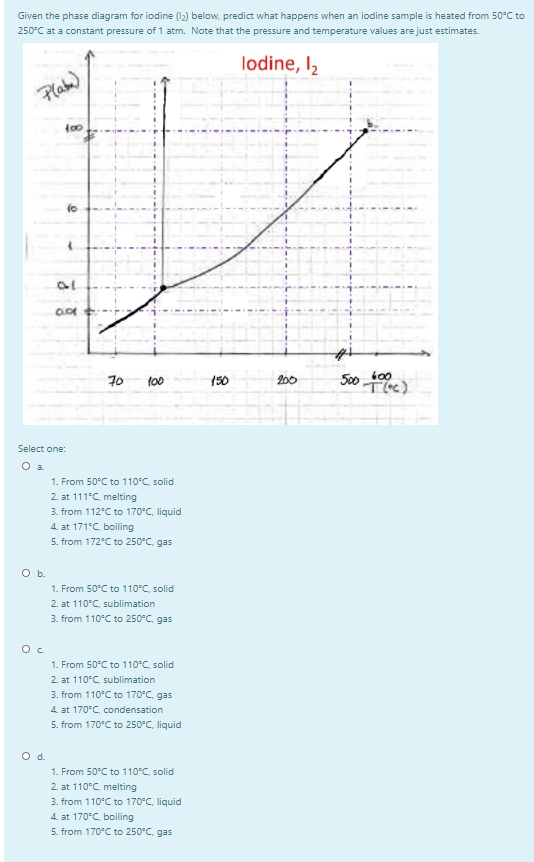Chemistry: The Molecular Science
5th Edition
ISBN:9781285199047
Author:John W. Moore, Conrad L. Stanitski
Publisher:John W. Moore, Conrad L. Stanitski
Chapter9: Liquids, Solids, And Materials
Section: Chapter Questions
Problem IISP
Related questions
Question
Given the phase diagram for iodine (I2) below, predict what happens when an iodine sample is heated from 50°C to 250°C at a constant pressure of 1 atm. Note that the pressure and temperature values are just estimates.

Transcribed Image Text:Given the phase diagram for iodine (12) below, predict what happens when an iodine sample is heated from 50°C to
250°C at a constant pressure of 1 atm. Note that the pressure and temperature values are just estimates.
lodine, I,
Plaba)
al
500 t00
Tec)
70
150
200
Select one:
1. From 50°C to 110°C, solid
2. at 111°C, melting
3. from 112°C to 170°C, liquid
4. at 171°C, boiling
5. from 172°C to 250°C, gas
1. From 50°C to 110°C, solid
2. at 110°C, sublimation
3. from 110°C to 250°C, gas
1. From 50°C to 110°C, solid
2. at 110°C, sublimation
3. from 110°C to 170°C, gas
4. at 170°C, condensation
5. from 170°C to 250°C, liquid
Od.
1. From 50°C to 110°C, solid
2. at 110°C, melting
3. from 110°C to 170°C, liquid
4. at 170°C, boiling
5. from 170°C to 250°C, gas
Expert Solution
This question has been solved!
Explore an expertly crafted, step-by-step solution for a thorough understanding of key concepts.
Step by step
Solved in 2 steps with 1 images

Knowledge Booster
Learn more about
Need a deep-dive on the concept behind this application? Look no further. Learn more about this topic, chemistry and related others by exploring similar questions and additional content below.Recommended textbooks for you

Chemistry: The Molecular Science
Chemistry
ISBN:
9781285199047
Author:
John W. Moore, Conrad L. Stanitski
Publisher:
Cengage Learning

Physical Chemistry
Chemistry
ISBN:
9781133958437
Author:
Ball, David W. (david Warren), BAER, Tomas
Publisher:
Wadsworth Cengage Learning,

Chemistry: Principles and Practice
Chemistry
ISBN:
9780534420123
Author:
Daniel L. Reger, Scott R. Goode, David W. Ball, Edward Mercer
Publisher:
Cengage Learning

Chemistry: The Molecular Science
Chemistry
ISBN:
9781285199047
Author:
John W. Moore, Conrad L. Stanitski
Publisher:
Cengage Learning

Physical Chemistry
Chemistry
ISBN:
9781133958437
Author:
Ball, David W. (david Warren), BAER, Tomas
Publisher:
Wadsworth Cengage Learning,

Chemistry: Principles and Practice
Chemistry
ISBN:
9780534420123
Author:
Daniel L. Reger, Scott R. Goode, David W. Ball, Edward Mercer
Publisher:
Cengage Learning

Principles of Modern Chemistry
Chemistry
ISBN:
9781305079113
Author:
David W. Oxtoby, H. Pat Gillis, Laurie J. Butler
Publisher:
Cengage Learning

Chemistry: Principles and Reactions
Chemistry
ISBN:
9781305079373
Author:
William L. Masterton, Cecile N. Hurley
Publisher:
Cengage Learning

Chemistry & Chemical Reactivity
Chemistry
ISBN:
9781133949640
Author:
John C. Kotz, Paul M. Treichel, John Townsend, David Treichel
Publisher:
Cengage Learning